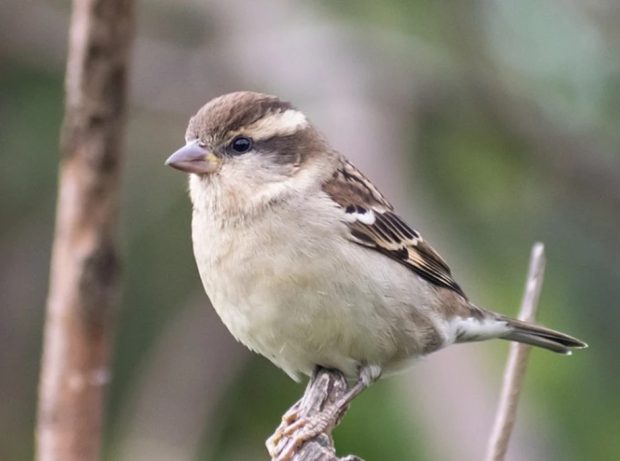
World Sparrow Day: Conservation efforts offer hope for sparrows’ return to Delhi
PTI, Mar 20, 2023, 10:46 AM IST

Representative image (Source: Pixabay)
House sparrows, small fuzzy birds recognisable by their distinct chirping and black, brown and white wings, went all but extinct from Delhi’s urban areas around 2012, prompting the then chief minister and avid bird lover Sheila Dikshit to declare it the state bird and initiate a slew of conservation measures.
Eleven years since, sparrows are once again showing themselves to those with patience and keen eyes, fluttering between trees, sitting on ledges and hopping from one windowsill to another.
Despite their growing numbers in the national capital, experts said on Sunday, the eve of World Sparrow Day, that the road to recovery is long and riddled with obstacles endemic to the modern urban landscape.
”Since 2012, there has been a great improvement in sparrow numbers, largely due to people’s participation and increased awareness. However, the modern lifestyle and infrastructure do not support house sparrows. Hence, the sightings are limited to areas like Old Delhi, JNU campus and forests,” Surya Prakash, a retired zoologist from Jawaharlal Nehru University’s School of Life Sciences, told PTI.
Buildings without balconies and windows, fewer crevices for sparrows to build nests in, use of pesticides that to eradicate insects and depletion of native plantations are some of the major reasons behind the sparrow’s disappearance.
”It is also because of the increased population of common mynas and domestic pigeons as they have taken over all the nesting places and feeding grounds of sparrows,” Prakash said.
The State of India’s Birds 2020 (SoIB 2020) report put the house sparrow in the ‘Low Concern’ category, noting that even though its numbers have decreased in large cities, they remain ”roughly stable overall”.
Nature Forest Society’s Mohammed Dilawar, who started the practice of observing March 20 as World Sparrow Day in 2010, noted that human intervention is essential for the conservation of sparrows.
”Sparrows cannot prosper without humans, their nesting and feeding are dependent on humans and their lifestyles. It is also important to understand how everything is connected. Depletion of native plants has led to a decrease in insects which has further removed the first food option for sparrow chicks,” Dilawar told PTI.
Dilawar and his organisation have been spreading awareness about this ”cascading effect” and encouraging people to plant native species of plants, not use pesticides and install feeders and nest boxes outside their houses.
A combination of these remedies has helped the Bombay Natural History Society (BNHS) and the Delhi government create a ‘Goraiya Gram’ (Sparrow Village) on the banks of the Yamuna river.
Located inside the Garhi Mandu forest in east Delhi, the pilot project of ‘Goraiya Gram’ has attracted a number of house sparrows that feed at a special ‘insect hotel’.
”We have created a safe space for sparrows by providing them with the right type of native plants to feed on and nest in. We have also put artificial nest boxes for the sparrows. Moreover, we have created an ‘insect hotel’, a microhabitat for different types of insects that play a very important role in maintaining a healthy population of sparrows,” said Sohail Madan of the BNHS.
The conservation organisation has also grown native grasses like jowar, bajra and munj as well as shrubs like jungli karonda and others that grow small wild berries for the sparrows to feed on.
”A lot of locals have taken up the project, basically adopting the area. Earlier there were no sparrows, but now there are a lot of them. There hasn’t been any formal counting so far.
”It is a pilot project for now. If it does well, we will be replicating it in other forest areas,” Madan said.
Similar initiatives by people have also started bearing fruit.
Nearly eight months after she installed a feeder and a nestbox in the balcony of her New Friends Colony house, Nini Taneja was visited by a house sparrow.
”It is a long process and there is no looking back. It requires a lot of patience and dedication.
”But once they start coming in, it is a joy to see them,” said the bird enthusiast-cum-painter.
”I organise art classes and I meet children who have never seen sparrows. So they become aware of this important part of our ecosystem through my artworks,” she said.
Sparrows, which frequently feature in Taneja’s paintings, are now also frequent visitors to her residential colony in south Delhi, inspiring others to install feeders and nest boxes in their balconies.
Udayavani is now on Telegram. Click here to join our channel and stay updated with the latest news.
Top News

Related Articles More

A 4.45 billion-year-old crystal from Mars reveals the planet had water from the beginning

Charmadi Ghat highway set for widening: Work likely to begin in January 2025

Key to past: Indore man collects 570 typewriters from across the world

Kambala: Tradition and modernity in coastal Karnataka

Dairy farmers in K’taka border areas selling milk to Kerala for higher price!
MUST WATCH
Latest Additions

CM Vijayan opens Huddle Global; Says Kerala will be key player in India’s deep tech ambitions

Bengaluru to host Aero India 2025 from Feb 10-14

Karnataka cabinet decides to reopen graft case against Ex-CM Yediyurappa and family

Man attacks nurse inside hospital, caught on camera

Special tribute concert for legendary singer SPB to be held in Bengaluru on Dec 8
Thanks for visiting Udayavani
You seem to have an Ad Blocker on.
To continue reading, please turn it off or whitelist Udayavani.

















